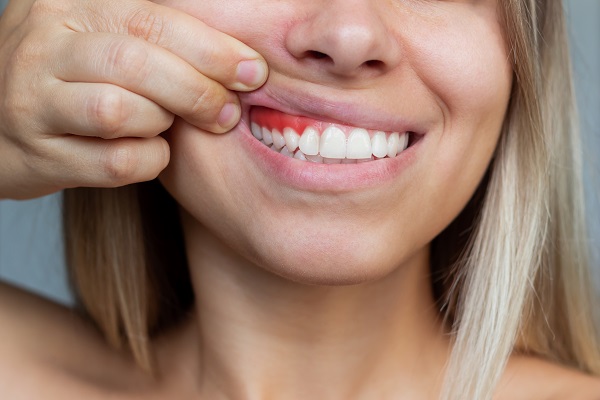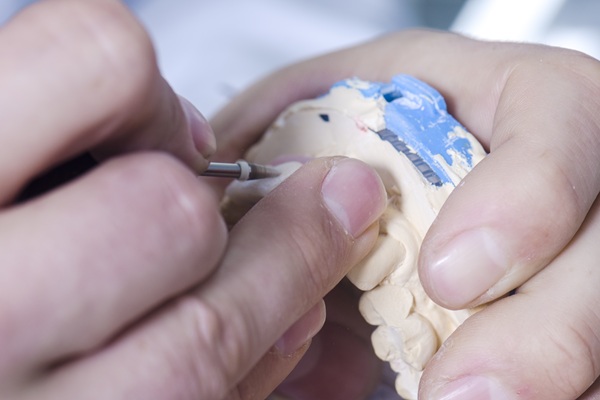How Gum Disease Is Treated by Your Dentist

Gum disease is one of the most common issues that dentists treat. It is most likely to affect people over 30, and the bacteria that live inside the mouth cause it. Also known as periodontal disease, gum disease develops when bacteria infect gum tissues.
Poor oral hygiene is one of the leading risk factors for gum disease in general dentistry. A person’s genetics can also increase their risk of developing gum disease, as well as habits like using tobacco products. Gum disease can be reversed early on, but it becomes a chronic infection if allowed to progress.
How our dentist helps patients with gum disease
Gum disease occurs in two primary stages: gingivitis and periodontitis. Gingivitis can be reversed and often comes with symptoms like bleeding, tender and/or receding gums. Periodontitis is the advanced stage of gum disease, and it causes permanent damage to teeth and bone structures. It is the leading cause of adults losing their teeth. Treatments that our dentist might recommend to help reverse gingivitis include the following.
1. Educating patients about oral hygiene
Improving a patient's commitment to proper dental hygiene can help stop the infection in their gums. A dentist might recommend brushing at least two times a day. Brushing after every meal works best because it gets rid of sugars in the mouth before bacteria turn them into plaque and acids. A good mouthwash also helps protect gum tissues. A dentist might prescribe a therapeutic mouthwash for patients with gingivitis.
2. Teeth cleanings
Teeth cleanings help get rid of plaque and tartar buildup on teeth. Bacteria in the mouth create plaque, which houses them and the acids that they make. Plaque hardens into tartar when left on teeth surfaces, and it also accumulates on teeth roots and gum pockets.
Teeth cleaning involves using a scaler to remove tartar deposits that protect bacteria infecting gum tissues. Treatments that our dentist might recommend for patients with more advanced cases of gum disease include the following.
Deep cleaning: Deep teeth cleaning is a more thorough version of conventional teeth cleaning. It involves removing tartar from teeth and their roots. Teeth roots are also polished during the procedure, so it is harder for tartar deposits to form on them.
Bone grafts: Bone grafts can be used to repair damage to bone structures in the mouth caused by gum disease. The treatment often involves using donor or artificial grafting materials to stimulate bone tissue growth in the area being treated.
Gum grafts: Gum grafts can be used to fix damage to gum tissues like receding gums. This improves how the patient’s smile looks, and it protects teeth roots from acids in the mouth. The donor tissue is typically taken from healthy parts of the patient’s mouth and grafted over the teeth roots.
Frequently asked questions about gum disease
Think you have gum disease? Let us go over some questions you might have:
1. Is gum disease reversible?
Gingivitis, the early stage of gum disease, can be reversed by improving your oral hygiene combined with teeth cleanings. Deep cleanings, a more extensive form of teeth cleaning, can also help to reverse gingivitis.
However, periodontitis, the advanced stage of gum disease, cannot be reversed. The infection is typically managed with treatments like deep cleanings, gum flap surgery, gum grafts, and bone grafts.
2. What happens if gum disease is left untreated?
Periodontal disease is the leading reason adults lose teeth. The damage often starts with receding gums that leave teeth roots exposed. This leaves them vulnerable to acids made by bacteria in the mouth. Teeth roots do not have enamel covering them, leaving them more susceptible to the acids made by bacteria in the mouth.
When left untreated, the condition progresses into periodontitis that damages bone and tissue structures surrounding teeth. Teeth will eventually become loose due to these structures being damaged, and they will eventually fall out of their sockets. Gum disease is also linked to chronic health issues like diabetes and heart disease, so not getting it under control can lead to problems in other parts of the body.
3. What are the symptoms of periodontal disease?
Gum disease often does not show any symptoms during its early stages. The first symptoms to show up include receding, tender, reddish, inflamed gums. Other symptoms that might emerge as the infection worsens include bad breath, loose teeth, and exposed teeth roots.
Gum disease requires immediate treatment
Periodontal disease can lead to your teeth falling out, and it is also linked to health issues, like heart disease. Call or stop by our Rockville clinic to learn more about the gum disease treatments that we provide.
Request an appointment here: https://whiteflintfamilydental.com or call White Flint Family Dental at (301) 273-1085 for an appointment in our Rockville office.
Check out what others are saying about our dental services on Yelp: Gum Disease in Rockville, MD.
Recent Posts
Gum disease is a common yet serious oral health issue that can cause discomfort, damage, and even tooth loss if left untreated. With the right gum disease treatment, patients can not only stop the infection in its tracks but also restore the patient's overall oral health. Knowing the true impact of gum disease and how…
The CDC states that gum disease, also known as periodontal disease, is one of the leading oral infections in the United States. In addition, the National Institute of Health cites it as the most common culprit for adults losing teeth. Because the early stages of periodontal disease often do not have noticeable symptoms, many patients…
Gum disease is a serious condition that can result in a need for periodontal treatment. Treatment is needed in order to destroy the infection and prevent it from getting worse. Oftentimes, without treatment, a case of gum disease can become advanced, which can result in tooth loss, receding gums, and even jaw deterioration, all of…
A preventive dentist is a trusted partner in maintaining your oral health and preventing serious dental issues before they occur. This dental professional emphasizes regular care and education, supporting long-term wellness and reducing the need for extensive procedures. As the cornerstone of modern dental care, preventive dentistry underscores early detection, regular visits, and informed patients.A…


